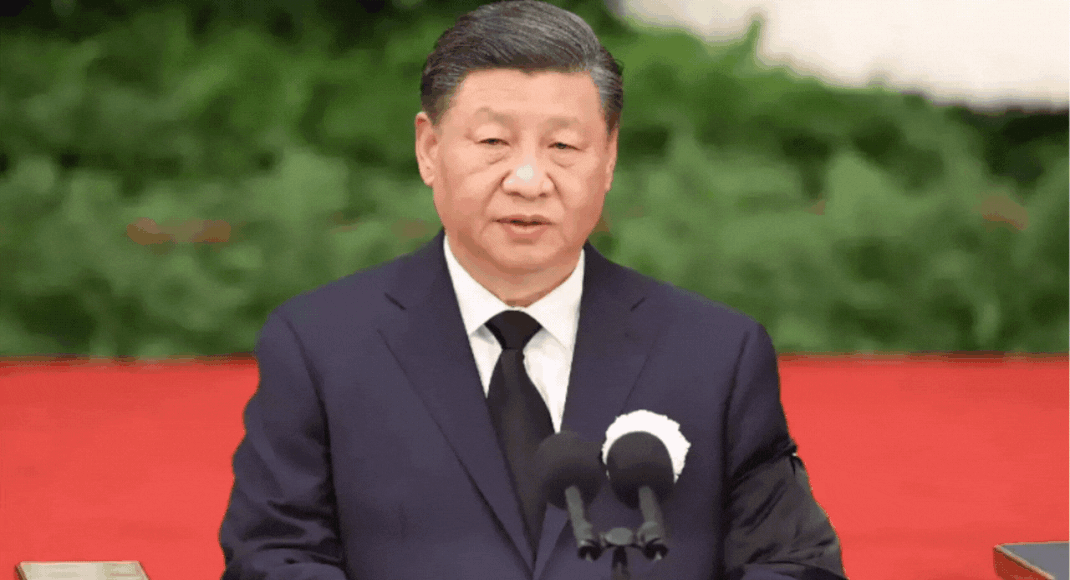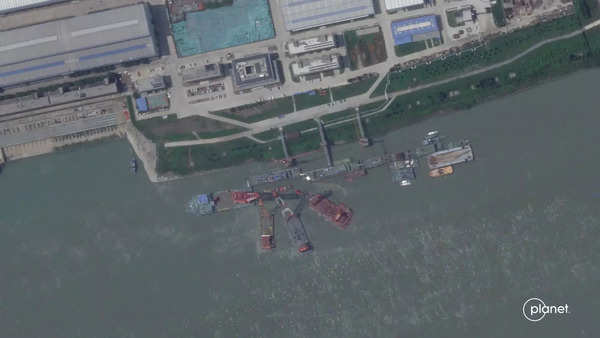
Setback for President Xi Jinping’s military modernisation efforts
In a setback for President Xi Jinping’s military modernisation efforts, China’s newest nuclear-powered attack submarine sank at a pier during construction between May and June, according to US intel reports.
Driving the news
- Satellite imagery recently uncovered that China’s newest nuclear-powered attack submarine, the first in its class, sank while under construction earlier this year, news agency AP reported quoting a senior US defense official.
- The vessel, identified as a
Zhou-class submarine , sank alongside a pier at theWuchang shipyard between May and June. - The incident, first reported by the Wall Street Journal, came to light after satellite images showed cranes attempting to lift the submarine from the bottom of the river.
- While the submarine has since been salvaged, the extent of damage, the exact cause of the sinking, and whether nuclear fuel was onboard remain unknown.
Why it matters
- The loss of China’s first Zhou-class nuclear-powered attack submarine is a significant setback for the country’s ambitions to build a world-class navy that can rival the US fleet.
- As China aggressively expands its naval capabilities, including nuclear-powered submarines, the incident raises questions about the quality of its military equipment, training standards, and the internal oversight of its defense industry, which has been plagued by corruption for years.
- In addition, the incident highlights the broader tension between the US and China, as both countries vie for military dominance, particularly in strategically important areas like the Taiwan Strait and the South China Sea.
- A senior US defense official, speaking anonymously to WSJ, indicated that the People’s Liberation Army (PLA) Navy has likely attempted to cover up the sinking. “It’s not surprising that the PLA Navy would try to conceal the fact that their new first-in-class nuclear-powered attack submarine sank pierside,” the official told the WSJ.
- “In addition to the obvious questions about training standards and equipment quality, the incident raises deeper questions about the PLA’s internal accountability and oversight of China’s defense industry—which has long been plagued by corruption.”

The big picture
- China’s naval modernization efforts have been central to its broader military expansion. The country already possesses the largest navy in the world, with over 370 ships, and it is rapidly expanding its fleet of submarines, surface ships, and naval aircraft.
- According to a 2022 Pentagon report, China currently has six nuclear-powered ballistic missile submarines, six nuclear-powered attack submarines, and 48 diesel-powered attack submarines. This fleet is expected to grow to 65 submarines by 2025 and 80 by 2035, as part of China’s long-term goal of achieving maritime superiority within the first island chain, a stretch of territory that extends from the Japanese archipelago through Taiwan and the Philippines to the South China Sea.
- The Zhou-class submarine that sank represents a critical component of this naval expansion. It is the first of a new class of nuclear-powered attack submarines, designed to bolster China’s undersea warfare capabilities. The vessel is notable for its distinctive X-shaped stern, which is intended to improve maneuverability.
- The Zhou-class submarines are part of China’s broader efforts to build a blue-water navy capable of projecting power far beyond its shores and countering US naval presence in the region.
What they’re saying
- The Chinese government has remained tight-lipped about the incident. A spokesperson for the Chinese Embassy in Washington said, “We are not familiar with the situation you mentioned and currently have no information to provide.” This response is consistent with the PLA’s practice of downplaying or outright denying mishaps within its ranks, especially those that could tarnish its image of military competence.
- In Taipei, Taiwan’s defense minister Wellington Koo confirmed that Taiwanese authorities had monitored the situation. “We have a grasp of the situation through multiple intelligence and surveillance methods,” Koo said, though he did not elaborate further. Taiwan, which is under constant threat from Beijing, closely tracks Chinese military activities, particularly movements in the Taiwan Strait.
- Experts outside the US government have raised concerns about the potential environmental and safety risks posed by the submarine sinking. While it is unclear if the submarine was carrying nuclear fuel at the time of the incident, many speculate that it likely was. US officials have not detected any signs that Chinese authorities checked the water or surrounding environment for radiation, raising additional concerns about transparency and accountability.
- As per the WSJ report, Thomas Shugart, a former US submarine officer and an adjunct senior fellow at the Center for a New American Security, was one of the first to spot irregular activity at the Wuchang shipyard. Using commercial satellite imagery, Shugart noted the presence of large floating cranes, which he surmised could indicate that an accident involving a submarine had occurred. He later learned from US officials that the submarine in question was nuclear-powered.
- “Can you imagine a US nuclear submarine sinking in San Diego and the government hushes it up and doesn’t tell anybody about it? I mean, holy cow!” Shugart said in an interview with the WSJ. He added that while the submarine has since been salvaged, it will likely be many months before it can be put to sea again. “The whole boat would be full of water. You’d have to clean out all the electronics. The electric motors may need to be replaced. It would be a lot of work,” he explained.
- Commander Ryan Ramsey, a former captain of a nuclear-powered submarine in the Royal Navy, shared his insights with Daily Mail regarding the recent incident. “It will be a setback and it’s really embarrassing. But they are good at learning quickly and moving on,” he said.
Between the lines
- The Zhou-class submarine’s sinking could have far-reaching implications for China’s military modernization efforts. As China pushes to build a fleet of nuclear-powered submarines capable of competing with the US Navy, this incident could slow its plans and raise questions about the reliability of its military technology. Brent Sadler, a senior research fellow at the Heritage Foundation and a retired US Navy nuclear submarine officer, called the sinking “significant.” “The sinking of a new nuclear sub that was produced at a new yard will slow China’s plans to grow its nuclear submarine fleet,” he told the WSJ.
- China’s undersea capabilities are crucial to its broader naval strategy, particularly in terms of deterring US intervention in a potential conflict over Taiwan. The PLA Navy’s submarine fleet, which includes both nuclear-powered and diesel-powered vessels, is designed to operate in the “first island chain” and beyond, where it could challenge US and allied naval forces in the event of a regional crisis. The Zhou-class submarine is seen as a key asset in this strategy, making its loss all the more consequential.
- While China’s naval buildup has been impressive, the submarine’s sinking underscores the challenges the country faces in closing the technological gap with the US. Undersea warfare has long been an area of US advantage, and while China has made significant strides in recent years, it still lags behind in certain areas, particularly in terms of submarine technology and training. The incident at the Wuchang shipyard could force Beijing to reassess its approach to naval modernization.
What’s next
- For now, the PLA Navy is likely focused on repairing the damaged submarine and conducting an internal review of the incident. However, the loss of the Zhou-class vessel may prompt broader changes within China’s naval program, including increased oversight and stricter quality control measures. The Chinese government has been tight-lipped about the sinking, and it is unlikely that any official acknowledgment will be forthcoming. However, the incident will undoubtedly weigh heavily on China’s naval leadership as it continues to push for parity with the US.
- In the meantime, tensions between the US and China are likely to remain high, particularly in the Indo-Pacific region, where both countries are vying for influence. The PLA Navy’s submarine force will continue to play a key role in China’s efforts to project power and deter US intervention in the region. However, the sinking of the Zhou-class submarine serves as a stark reminder that China’s naval modernization is not without its setbacks.
(With inputs from agencies)




